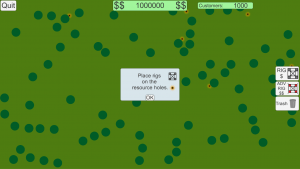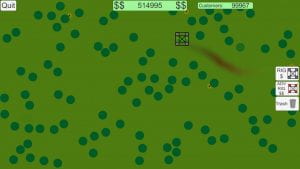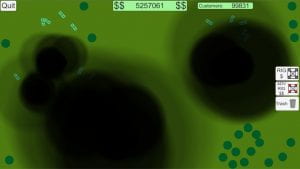Artist Statement:
My objective in making this game was to draw attention to the real world problem of consuming resources without first diligently seeking to understand the negative effects that can occur. Humans have a great need for energy to power our lives, and this need is only increasing. To supply ourselves with the energy we need, we often use resources in a way that either causes harm to our environment or causes the resources to run out. In either case, our use of the resource is limited, either by the amount available or by the deleterious cost using it brings. Oil may be plentiful for the time being, but eventually it will run out. Pollution of our environment ruins our air and the ecosystem that we need to survive. Both facts should constrain our use of certain resources.
However, the drive to use resources that are limited is primarily motivated by financial greed. Alternate, longer lasting and less limited or unlimited methods of obtaining resources could be developed, but it is much more financially lucrative to exploit the more readily available, but limited and potentially harmful resources. If this is the path humans follow, then our futures are not especially bright. This is the narrative my game follows.
Most of my inspiration for making this game comes from the anti-war artworks created by many of the Dada artists. Dada primarily started as a reaction to World War I and it was known for its mockery of materialism. I felt that while war is still a large issue today, it is not what it was when Dada began. Instead, we are faced with other very big issues, issues of which greater awareness is needed. This is why I chose the topic of resource consumption. Our reliance on fossil fuels has gone on far too long and the environmental effects have become apparent everywhere.
Conceptual art was a major theme in Dada. In fact, the idea of creating aesthetically pleasing art was sometimes even mocked. This is why I kept the graphics very simple and representational, as opposed to intricate, pleasing designs. It is purposefully designed to support the message of the artwork as a whole, rather than being visually pleasing as an individual part. Hans Arp made use of chance when creating his art, so I made use of chance as well in the generation of the “worlds” that the player encounters in my game. The number of trees, resource points, and their locations are all random. Not only does this keep there from being any two games that are the same, but it also examines the different situations that can occur when chance takes the generation of a “world” to an extreme. I also liked the idea of the world not being a handcrafted place because the real world is also far from being handcrafted.
A final inspiration I would like to mention is Brenda Romero’s game Train. In this game, the player is not informed of what end state they are actually working towards accomplishing, but are merely given instructions on how to reach the end state. Upon reaching the end state, the players realize they are loading train cars and shipping people to Auschwitz. I thought that this method for revealing the game’s message would work well in my game as well. So, in my game I kept my instructions brief and the player (without any explanations before hand) should not understand that they are ruining the world until it is too late.
Game Overview:
The game is designed so you really cannot win, unless you do not actually interact with it, which of course is acceptable. When the player starts the game, they receive a small help tip that tells them to place “Rigs” on “Resources points.”

They click “ok” and can then fully see the generated world, which should include a moderately populated forest and a handful of resources points. If the player was to observe the forest and just watch for a moment, they would notice that the trees spread and the forest thickens. There are two “counters” at the top of the screen. The first shows the amount of money the player has available to them, which they can spend on “Rigs.” The second counter is labeled “customers,” but its representation is deeper than just a “customer.” The player will receive more money for each customer that they have, but this number can go up or down. For the purpose of the game, you are the only producer of energy in the area that your customers exist in, so they will always buy from you. They are also affected by any damage you might cause to the environment. So, if the customer counter starts to drop, your customers are not simply going to another energy provider, they are dying.
The player can pick between two Rig types, a large and a small. The difference is a simple distraction for the player. I liked the idea that a player might think they could optimize how they extract resources to make more profit, but really they will always reach the same ending. The player can place the Rigs on the resources points, and when placed or “built” the Rigs start returning money, which is shown graphically with a puff of cash coming from each Rig as it generates revenue. While placing a Rig, the player can accidentally, (or on purpose) destroy trees, because any trees that the Rig collides with on its way to being built will be destroyed.

Over time, every Rig placed will start to produce pollution. This pollution gets larger and spreads across the map as the game progresses. The pollution kills any trees it comes in contact with and there is nothing the player can do to reverse its effects. The damage is permanent, just as it is in real life.


Notes:
In play-tests, the game was well received. The majority of the people who played the game were in our class, so they all had prior knowledge of what my game was about. This made it hard to test if the game was doing well in terms of only revealing its message once the player had already ruined the world.
I had two play-tests with people outside of our class, both of them thought the game was interesting. One suggestion I got was to make it more obvious that the trees were trees, which is something I had been thinking about improving as well. In both playtests, the response I got when the players understood what they were doing was “Oh no!” and “What the heck is that crap?!”.
Both of those responses made me pretty happy because to me it meant that the realization that they had messed something up came all at once, and too late.

Download zipped game:
Mac – LimitedMac
PC – LimitedPC
